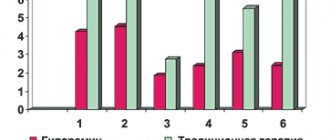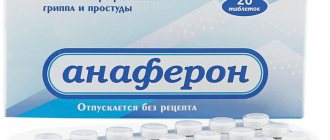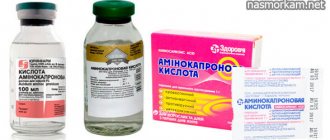Acute respiratory infections enter the body through the respiratory tract and primarily affect the respiratory system. Infection occurs through contact with an infected person, usually through airborne droplets. The main symptoms of ARVI are similar: fever, runny nose, sneezing and sore throat. ARVI can be caused by dozens of viruses, but only a few are the most studied and diagnosable.
Types of respiratory infections
Rhinovirus infection is the most common among acute respiratory viral infections, affecting the nose and nasopharynx. The viruses that cause the disease are the picornavirus family, which are active year-round but are most aggressive in April and September. A person who has recovered from the disease has virtually no immunity, so you can become infected several times in a year.
Symptoms appear after 1–5 days, including nasal congestion, runny nose, chills, sneezing, sore throat, mild cough, watery eyes. Body temperature rarely rises above 38 degrees. If a bacterial infection does not occur, the symptoms disappear in about a week and the person recovers.
Adenoviral infection affects the respiratory tract, eyes, lymphoid tissue, and digestive tract. Symptoms appear 5-7 days after infection. Worries include a runny nose, fever (38-39 degrees), hoarseness, cough, lacrimation, acute conjunctivitis, weakness, joint pain, diarrhea. Adenoviruses are active in the autumn-winter period; they are not afraid of low temperatures, but quickly die from ultraviolet radiation and chlorine.
Respiratory syncytial infection affects the lower respiratory tract and can spread to the small bronchi and bronchioles. Symptoms are similar to other acute respiratory viral infections: chills, low-grade fever, serous-mucous nasal discharge, shortness of breath. A characteristic feature is a dry paroxysmal cough. The virus is most active in the winter-spring period and spreads quickly in groups. Children under three years of age are very susceptible to MS infection; they suffer the disease most severely.
Coronavirus infection occurs after infection with one of the coronaviruses. To date, seven coronaviruses that infect humans have been studied, the most famous COVID-19 being just one of them. Coronaviruses strike the upper and middle parts of the respiratory tract: nose, pharynx, larynx, trachea, bronchi. The symptoms of all coronavirus infections are similar: malaise, weakness, chills, mild headaches, increased body temperature. Some types of this type of virus cause rhinitis.
The acute course of COVID‑19 is characterized by high fever, dry cough, loss of taste and smell. Covid has a high spread rate and is dangerous due to complications, one of which is pneumonia. However, a severe course of the disease is typical for weakened people with a “bouquet” of other diseases. Most suffer from Covid in the same way as other ARVIs.
Influenza can also be classified as an acute respiratory viral infection, since its causative agent is viruses transmitted from the carrier of the infection by airborne droplets through the respiratory tract during talking, coughing and sneezing. Influenza epidemics occur in autumn and winter and are caused by several of the most aggressive subtypes of viruses. The symptoms are pronounced: high fever, headache, dry mouth and nose, photophobia, dry cough with chest pain.
Division by family
One of the families of acute respiratory viral infections is the orthomycoviruses. This family, for example, includes influenza viruses. Doctors note that from a clinical point of view, it is quite logical to include influenza in the classification of ARVI, since this corresponds to the manifestations of pathology. Influenza stands out in a special group because of its ability to lead to epidemics and pandemics.
Exercise for the lungs. Simple workouts for the prevention of ARVI Read more
Another option is parmycoviruses. They include parainfluenza viruses, the clinical picture of which is represented by fever, laryngitis and bronchitis. In children, such viruses lead to severe development of laryngitis with the manifestation of acute swelling and sometimes stenosis, which is popularly called false croup.
The picornavirus family includes 4 genera, the most prominent representatives of which are rhinoviruses and enteroviruses.
The reovirus family often affects newborns under six months of age; adults are less likely to be affected. The manifestations of infection with them are varied, so the diagnosis can often be made using laboratory tests.
The adenovirus family has 47 serotypes, grouped into 7 groups. Some of them can lead to the development of diseases accompanied by inflammation of the pharynx, enlarged tonsils, fever and general intoxication and weakness. The lower respiratory tract may be involved in the pathological process, which leads to manifestations of pneumonia.
Not only ARVI. What can cause a fever? More details
Complications of ARVI and their danger
In a person with good immunity, acute respiratory diseases go away within a few days, especially if the body is helped to cope with viruses. It is recommended to drink more water, rinse your nose, and gargle. Symptoms can be stopped - bringing down the temperature above 38 degrees, fighting a runny nose, treating the throat with emollients.
However, in some cases, severe viral intoxication or the addition of a bacterial infection can cause complications. Most often, complications arise in the respiratory system and lead to other diseases: tonsillitis, sinusitis, rhinitis, pharyngitis, laryngitis. Often, ARVI develops into bronchitis, otitis media, sinusitis, and pneumonia.
More serious consequences of ARVI threaten people with weakened immune systems. A respiratory infection may not be limited to the respiratory tract and spread to other organs. Severe complications include: pyelonephritis, nephritis, rheumatoid arthritis, neuroinfection.
Adenoviruses
This is a whole group that includes 50 varieties. They cause pathologies of the respiratory tract, but, unlike many other viruses, they can also affect other body systems - the conjunctiva, lymph nodes, and gastrointestinal tract. Adenoviruses lead to an increase in body temperature to high values, as well as inflammation of the mucous membranes of the respiratory tract and eyes. This infection is highly contagious. Infection with adenoviruses can lead to acute respiratory viral infections, viral pneumonia, acute adenoviral tonsillitis, acute conjunctivitis, and intestinal infections. Adenoviruses account for 5-10% of diseases. The main methods of transmission are airborne and household.
Symptoms of infection with adenoviruses include inflammation of the respiratory tract, moderate general intoxication, sore throat, rare cough, and in children there may be inflammation of the tonsils and sore throat.
The infection is fraught with complications if treatment is not carried out or is carried out incorrectly. Among them:
- otitis;
- adenoviral pneumonia;
- pathologies associated with the heart and blood vessels - this is in the case of severe cases;
- pathologies of internal organs - the spleen, kidneys, liver are affected;
- exacerbation of chronic pathologies;
- neurointoxication;
- swelling of the walls of the bronchi.
Treatment should be prescribed by a specialist and adjusted if necessary and after studying the course of the situation.
Flu nuances. What misconceptions about this ARVI are still strong? More details
Prevention of respiratory diseases
Prevention of ARVI is aimed at increasing immunity. There are many known folk ways to increase the body's defenses: hardening, a diet rich in vitamins, and the use of natural phytoncides, for example, garlic.
In order not to become infected, it is necessary to take precautions: maintain a safe distance, reduce contact during periods of epidemics, wash your hands more often, ventilate the premises, dress according to the weather, avoiding hypothermia.
Vaccination provides the most effective protection against viruses. It is necessary to get vaccinated against influenza every year. You can get a pneumococcal vaccine to prevent severe pneumonia.
Diagnosis of respiratory viral infections
If after a few days you cannot cope with the cold on your own, you should consult a doctor. Modern diagnostic methods make it possible to identify the type of virus at an early stage and prevent complications.
At the Anapa Diagnostic Center you can undergo examinations, undergo fluorography, and take sputum, blood and urine tests. If a bacterial infection is suspected, a bacteriological culture will be performed. Having identified the causative agent of the disease, effective treatment will be prescribed. Call and make an appointment; the earlier treatment is started, the lower the risk of complications.
Modern approaches to the treatment of acute respiratory infections and acute respiratory viral infections in adults
To avoid the development of complications, acute respiratory diseases must be treated. Such a reasonable approach will allow the patient not only to cope with the ailment without dangerous consequences, but will also provide the opportunity to feel better during the period of illness. Your doctor will prescribe antibiotics to fight the bacterial infection. If the disease is caused by fungi or parasites, then special medications will be required that are designed to eliminate these pathogens.
Etiotropic therapy, aimed at combating the immediate cause of the disease in acute respiratory infections and acute respiratory viral infections, in most cases is combined with the use of symptomatic drugs in the form of antipyretics, cough medicines, various sprays and expectorant syrups.
Drugs for etiotropic therapy
Etiotropic drugs that can help quickly cope with acute respiratory viral diseases, including influenza, include antiviral drugs. They are divided into specific, aimed at combating a specific type of virus, and non-specific, which have a wide range of antiviral activity. The difficulty of using specific antiviral drugs is that the specific strain of influenza or other infection that led to the disease is not always known. But nonspecific antiviral drugs are capable of fighting various types of viruses at any stage of their development. Modern antiviral drugs of the latest generation affect only virus-specific processes, with virtually no effect on the biochemical and physical functions of the cell. One of these drugs is VIFERON Suppositories (suppositories).
Drugs for antiviral therapy
The drug VIFERON Suppositories (suppositories) has a direct antiviral effect, because it contains interferon alpha-2b, which is the first to respond to the invasion of the virus, blocking its growth and reproduction. The complex composition of the drug (alpha-2b interferon + antioxidants (vitamins E and C)) increases antiviral activity. This drug can be used without age restrictions, including in children from the first days of life, as well as in pregnant women from the 14th week of gestation.1
Viferon suppositories for ARVI
The rectal method of taking the drug ensures the rapid action of the drug through the dense network of blood vessels of the rectum, and also makes it possible to avoid side effects on the liver, stomach and intestines. It has been clinically proven that a drug administered rectally reaches the circulatory system in a concentration sufficient for treatment. This means that taking the drug VIFERON Suppositories (suppositories) helps fight unpleasant symptoms such as cough, chills and lethargy. Suppositories not only allow the body to carry out anti-infective protection, but also restore the ability of immune system cells to produce their own interferon. The drugs VIFERON Ointment and VIFERON Gel can also help cope with acute respiratory viral infections.
Viferon Ointment for ARVI
Human recombinant interferon alpha-2b in combination with highly active antioxidants, which is included in VIFERON Ointment, helps fight influenza and other acute respiratory viral infections at any stage of the disease. The drug VIFERON Ointment is used in the treatment of a wide range of acute respiratory infections. Its original formula helps not only block the virus, but also restore immunity. When applied to the skin and mucous membranes, the components of the drug VIFERON Ointment easily penetrate inside, activate local immunity and prevent the multiplication of the virus. This allows you to cope with the disease faster and get sick less often in the future2.
For the treatment of influenza and other acute respiratory viral infections, VIFERON Ointment is applied in a thin layer to the mucous membrane of the nasal passages 3 times a day. The amount of the drug is one pea with a diameter of 0.5 cm, the approximate course of treatment is 5 days.







